Regenerative and organic gardening is about taking a page from Mother Nature when growing plants. Imitating what happens naturally in a forest or wildflower field can produce tremendous results in our home gardens. The best part? Making homemade sprays and solutions to enrich, treat, and maintain your plants is relatively easy and affordable. There are countless tips and tricks for regenerative and organic gardeners in this edition; let’s wrap things up with our list of 5 Cool Ways Homemade, Natural Solutions Help The Garden Thrive.
Boost Soil And Plant Health
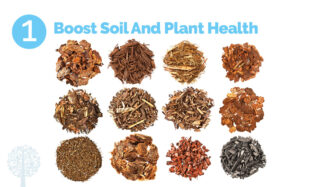

Mulching is a process not to be skipped in the regenerative and organic garden! This process warms the soil, enriches it with nutrients, and prevents erosion, water evaporation, and weeds from sprouting. One stone, so many birds! Compost is an excellent mulch that can easily be made using kitchen scraps and brown material from around the yard. Shredded leaves, wood chips, and seaweed are excellent forms of all-natural mulch, as are straw, grass clipping, pine needles, and cardboard. Living mulch, like a low-growing groundcover, works wonders and looks beautiful. And when a plant’s lifecycle ends, the chop-and-drop method of mulching involves cutting stems, leaves, and flowers back and allowing them to decompose naturally in the soil. Be sure the plant is pest and disease-free before attempting this at home.
All-Natural Fertiliser
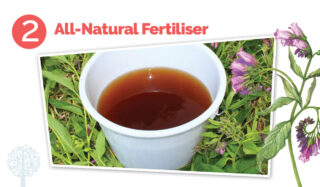

Not for the faint of heart, making comfrey tea stinks something fierce, but it works miracles as a fertilizer for fruiting plants! This homemade brew uses all-natural materials, boosts plant growth, and encourages better flowering. Perennials and annual veggie crops love it, so grab some gloves and a clothespin for your nose. Once you find a bushy comfrey plant in the garden, chop half the volume to about 2″ from the ground. Fill a bucket with the comfrey leaves, stems, and flowers, and add water to steep the plant material. After about two weeks, the tea will be ready; the darker and smellier the brew, the better! If you gag easily and know the stench will be too much to handle, you can simply add comfrey leaves to some mulch or compost, but the benefits won’t be as immediate. If you’re tough as nails like Garden Culture’s Martyna Krol, check out her article on making comfrey tea fertilizer.
Dampening Off and Powdery Mildew
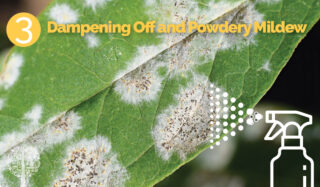

Dampening off strikes seedlings in humid environments like grow rooms and greenhouses, appearing as a fuzzy moldy growth on stems and seeds. Luckily, there’s a homemade solution for this fungal disease! Chamomile tea is easy to make; combine 1 part fresh chamomile with 3 parts rainwater or dechlorinated water in a mason jar and place on a sunny windowsill for a day. Strain and use the mixture to water seedlings or put it into a spray bottle to mist the plants and soil daily. You can also use this tea as a foliar spray to prevent disease in mature plants. Of course, in the dog days of summer, no outdoor garden is spared from the clutches of powdery mildew. These ‘powder’ spots are typically found on cucumber and squash plants and spread rapidly. Prune and discard the affected leaves before applying a classic milk spray to the remainder of the plant to prevent further spread. Mix 1 part cow’s milk to 3 parts water and apply in direct sunlight. You can use it every few weeks as preventative medicine or every three to five days when disease strikes.
Chamomile Tea recipe courtesy of Garden Alchemy 80 Recipes and Concoctions for Organic Fertilizers, Plant Elixers, Potting Mixes, Pest Deterrents and More, by Stephanie Rose.
Pest Problems
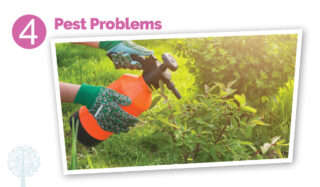

When pests show themselves in the garden, many gardeners look to kill. Unfortunately, other beneficial bugs might fall victim to our eradication efforts. Before going to the extreme, try repelling pests instead. A repellant will mask the scent or change the taste of the plant, encouraging pests to look for food elsewhere. We all go home happy! Joe Lamp’l offers his favorite homemade insect repellent in The Vegetable Gardening Book: Your complete guide to growing an edible organic garden from seed to harvest. You’ll need your gloves for this spicy brew! He recommends blending 2 cups of water with 2 cups of hot peppers. Strain the solution through a cheesecloth and pour the liquid into a spray bottle. Don’t have peppers on hand? Replace them with 2 garlic cloves instead! Or, if the pest situation is out of control, use garlic and hot peppers. Lamp’l suggests adding dish soap to the solution to help it stick to the plants.
Supercharging Soil
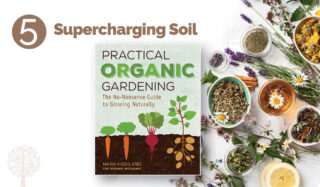

We’re saving the most complicated homemade garden amendment for last. Biochar is garden gold! An ancient technology thousands of years old, the native people of the Amazon created charcoal, mixed it into their soil, and watched as the beautiful earth became more productive than ever. According to Mark Highland, author of Practical Organic Gardening: The No-Nonsense Guide to Growing Naturally, even 2,000 years later, crops can be grown in biochar-enriched soil with little to no additional fertilizer application. Biochar is made through pyrolysis, the process of burning organic materials without oxygen. The result is a highly-porous carbon that improves nutrient adsorption and offers a permanent home to soil biology. Believe it or not, you can make small amounts of this miracle soil enhancer at home using a top-lit updraft stove (TLUD); a quick online search will teach you everything you need to know. Highland says when using a TLUD, each batch makes about one to two cups of biochar ready to offer your plants more than a lifetime of benefits.
![]()